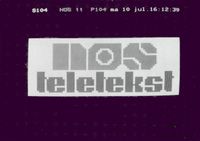On Tuesday April 1, 2005 the Dutch television information and subtitling service Teletekst existed 25 years. It has been the longest running and most used new media service ever since.
The first mention of teletext, as the English generic name is for this technology, is made in a BBC internal memo on December 1970. On February 9, 1971 the BBC files for a patent On Teledata, the first teletext system. By October 1972 the service, dubbed Ceefax (See fax), is announced by the BBC and a series of trials are set. In January 1973 the first public demonstration of the Ceefax system took place in London. In April 1973 the Britain's Independent Broadcasting Authority announced a competing teletext system, named Oracle. (Historic data by David Carlson).

Test screen
Two employees of the NOS, Jan Buddingh and Cees Veenendaal saw Ceefax in 1976 and started lobbying for introduction in the Netherlands. On April 1, 1978 the Dutch broadcast foundation NOS started the experimental phase of Teletekst to experiment in a small church in Bussum outside broadcast city Hilversum. This period was closed with the launch of Teletekst. Project leader Wim Stokla managed a small department, which took care of the 100 pages, mainly news pages and pages with information on radio and television programs. But the department also took care of undertitling programs. On October 4,5, and 6, 1980 at the start of the new television season, the department took care of undertitling the trilogy Mourning becomes Elektra (Rouw past Elektra), a television play by John van de Rest.

Opening screen
Teletekst was in some way a source of confusion for new media novices. On September 5, 1978 even a symposium was held under the title Viewdata and Teletekst. People had to be given an explanation that teletext was a broadcast medium transported by the ether and forwarded by cable, while for videotext information was transported over the telephone line. But by its launch Teletekst was clearly profiled as a broadcast service. The service was even legally covered as a broadcast medium by defining it as a service with moving pages. The broadcast industry did not any interference by commercial parties. With the advent of commercial broadcast companies in 1989 the teletext system became also in commercial use.
The introduction of Teletekst took some time as television sets needed a particular chipset. For the launch special decoder boxes were sold. However the new television sets after 1980 had a built-in chip set; such a set bore the price tag of 3000 Dutch guilders (roughly less than 1500 euro). These days it is difficult to get a television set without a teletext chip set in the Netherlands.
The first computer could store 100 pages. At the end of 1981 the computer could hold 200 pages. The Teletekst editorial staff was extended and the NOS Teletekst service had become part and parcel of the broadcasting service, according to Wim Stokla. Eventually the amount of pages grew to 1000 pages. This created space for more information categories. So next to the news and broadcast information pages new services were linked into the services. One of the most popular services before the Internet era was the Schiphol service on departure and arrival times. When in 1989 the commercial broadcasting companies atrted to broadcast, they also started to use the teletext facilities for commercial use. In 1995 more than 80 per cent of the Dutch households had a television with Teletekst facility.
With the arrival of Internet, Teletekst got the PC as an extra outlet. In 1993 the NOS started its own Teletekst site. In 2000 the service got its own browser, which can be downloaded. In the meantime Internet and mobile phones are extra outlets for Teletekst. This also implies that the visits to the Teletekst pages on television are going down. By 2004 the viewing figure had gone down to 2,2, million people, a drop of 20 per cent since 2000.
Has Teletekst a future or will it be replaced by interactive teletext? Looking at the growth of setup boxes for digital television in Great Britain, the bell for teletext will toll in the near future. An interactive teletext service on a setup box looks more like an Internet news service and will offer more and better graphical information than the present teletext system. In the Netherlands the change over will take some time and depends on the change over from analogue broadcast to digital broadcast.

No comments:
Post a Comment